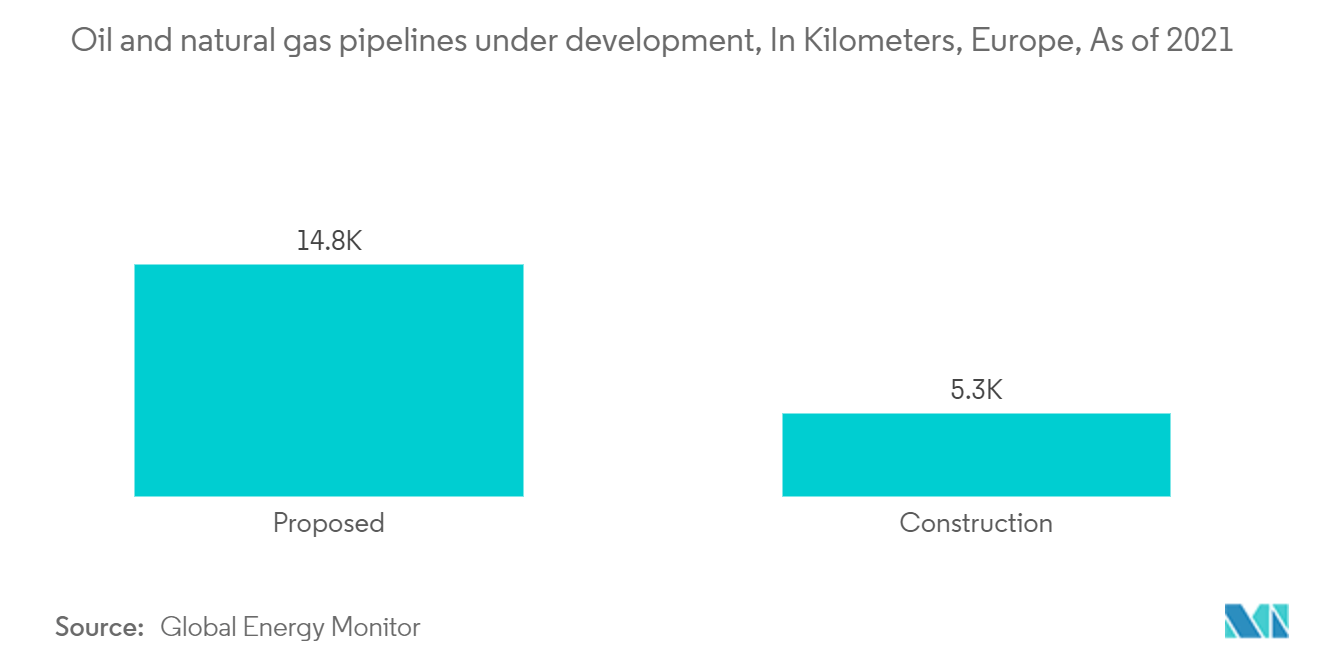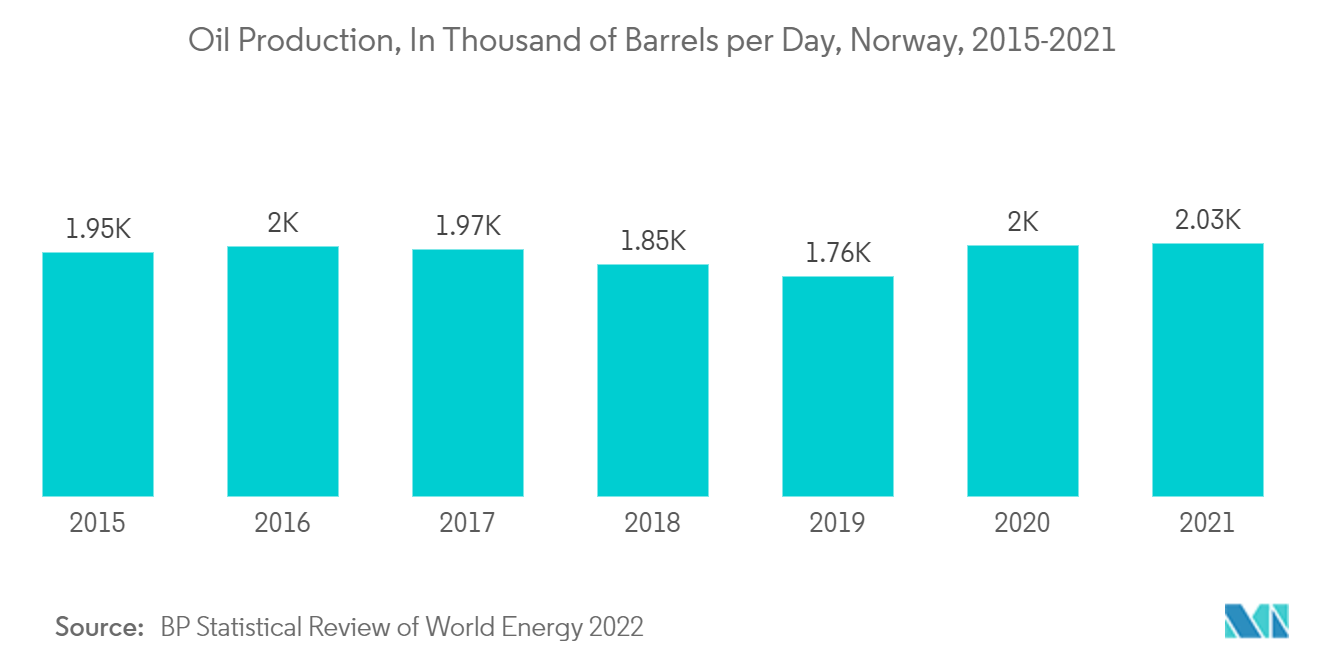Market Trends of Europe Line Pipe Industry
This section covers the major market trends shaping the Europe Line Pipe Market according to our research experts:
Stainless Steel Segment to Dominate the Market
- Stainless Steel pipes are used in a wide range of industries, from industrial manufacturing to sculpture, and have many advantages for industrial or residential projects. Steel tube is commonly used in plumbing to replace plastic pipes with stainless steel pipes. Stainless steel pipe is more expensive than the plastic pipe, but it has a number of advantages over the latter.
- According to the European steel association, the pipe and tubes industry is the fifth largest steel consumer, accounting for approximately 12% of total Europe steel consumption.
- There are many things to consider when building, managing, and operating a water waste treatment plant, such as what materials to use for aeration pipes, valves, tanks, and transfer pipes. The stainless steel used for these type of auxiliary equipment and pipelines are corrosive-resistant without adding toxic chemicals to the water, and also the need to keep maintenance and repair costs low.
- Steel grades 304 and 316 are commonly used in wastewater treatment processes and water filtering systems. Other materials were considered in the past but they did not outweigh the advantages offered by steel. There are a number of known substances that are used in plastics across Europe, such as HDPE, which is similarly chemically resistant to steel, but decomposes when exposed to light, creating a costly and difficult problem in the waste and water treatment industry.
- Oilfields and pipelines are just one of the many sub-industries that ensure the oil and gas industry maintains a stable supply of product to customers and distributors. A variety of raw materials are used to run the oil and gas industry which includes metals.
- There are many uses for stainless steel in the oil and gas industry, from harvesting to refining to shipping and distributing products. This metal is extremely strong and has great wear resistance, which makes it a popular material for exterior components and piping. Combining steel with small amounts of other metal elements improves its durability, strength, corrosion resistance, and other important characteristics.
- Stainless steel is an ideal material for a wide range of chemical plant applications, due to its strength and corrosion resistance. Stainless steel filters and seamless pipes are essential components of modern fluid systems. It is also important to consider the benefits of stainless steel in the pipe lines and units themselves, as well as as part of the overall design process.
- Stainless steel and steel pipes and tubes have excellent corrosion resistance, heat resistance, and low-temperature properties, and are often used as raw materials in petroleum refining processes, petroleum chemistry, water treatment and power generation operations.
- According to Global energy monitor, Europe has a total of 16 gas pipelines are under construction, totaling 3,200 kilometers (km) and costing EUR 6.5 billion. Of this, EUR 2.1 billion is earmarked for the Baltic Pipe Project, which is expected increase EU gas import capacity by 10 billion cubic meters per year.
- In the pre-construction phase, 62 proposed gas pipeline projects would stretch 12,500 km and cost EUR 29.7 billion. The EUR 12.1 billion would go to build 3,600 km of import pipelines and expand a capacity (the Trans Adriatic Pipeline), increasing EU gas import capacity by at least 69.5 billion cubic meters per year.
- In view of these factors, the usage of steel pipes in the wide range of end use industries are expected to dominate the market during the forecast period.

Norway to Dominate the Market
- There are many different types of pipelines, and they play a vital role in human health, as well as have strategic importance for all countries. Pipelines transport crude oil, refined petroleum, natural gas, biofuels, clean water, hot water, steam transport, and irrigation water.
- It is estimated that there are approximately 4,000,000 kilometers of pipelines in 120 countries, half of which are petroleum and gas pipelines. As a result of increasing energy consumption and energy politics of countries to secure their energy resources, oil and gas pipeline construction has been growing tremendously.
- According to European Commission, In 2012, the total length of oil pipelines in Norway was 1,245 kilometers, a value that remained unchanged until 2016. In 2016, the total pipeline length was 1,288 kilometers, which remained the same in 2019.
- Norway's pipeline network has a capacity of 120 billion Sm3 of dry gas per year. Three onshore gas processing plants are connected to the pipeline network, and receive rich gas from the fields. Norway has four receiving terminals in continental Europe (two in Germany, one in Belgium, one in France) and two in the UK.
- A Norwegian gas pipeline network has a total length of about 8,800 kilometers, which is about the same distance as from Oslo to Bangkok.
- Currently, Norway has 90 oil and gas fields, but this number may rise to 130 within a few years. Despite having just five million people, Norway is the world's 14th largest oil producer and 8th largest natural gas producer.
- Accoring to Norwegian Petroleum Directorate (NPD), Petroleum production in Norway is expected to grow by more than 9% by 2024 due to an increase in investment in the country's biggest export market. According to NPD forecasts, oil production will rise to 4.33 million barrels of oil equivalent in 2024, an increase of 9.1% over 2021's preliminary reading of 3.97 million barrels.
- In May 2022, Equinor and Halten East partnered with Var Energi, Spirit Energy and Petoro have decided in investing about NOK 9 billion in the development of the area neighbouring to the Asgard field in the Norwegian Sea. A plan to develop and operate the area has been submitted to the Ministry of Petroleum and Energy and consists of six gas and condensate discoveries and options on three further prospects.
- According to BP Statistical Review of World Energy, In 2021, Norway produced 2025 thousands barrels per day of oil, an increase of 15% from 2019.
- Therefore, based on the above-mentioned factors, Norway is expected to have a positive impact on the line pipe market during the forecast period.

